FIELD VETERINARY REPORT FOR AMBOSELI MOBILE VET UNIT FOR THE MONTH OF DECEMBER 2014 Report by Dr
FIELD VETERINARY REPORT FOR AMBOSELI MOBILE VET UNIT FOR THE MONTH OF DECEMBER 2014
Report by Dr. Michael Njoroge
Introduction
December was generally calm, despite a few injuries caused by spears and arrow heads that required clinical intervention. However, the Southern Conservation Mobile Veterinary Unit remained vigilant undertaking monitoring, surveillance and disease investigation activities, while also promptly attended to any cases that required clinical intervention. In addition to carrying out its usual duties in the Southern Conservation Area, the Amboseli Unit stood in for the Tsavo Conservation Area Mobile Vet Unit during December. In conjunction with the DSWT Aerial Support Unit, 3 reconnaissance flights were carried out during the month within the ecosystem, however no unusual sightings were observed during these operations. Monitoring of previously treated animals was also carried out and most of the clinical interventions were seen to have been a success.
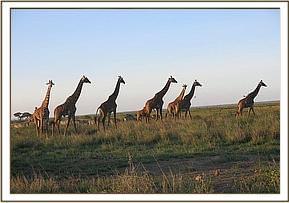

CASE#1 TREATMENT OF INJURED FEMALE ELEPHANT
Date: 9th December 2014
Species: African elephant (Loxodanta africana africana)
Sex: Female
Age: Adult
Location: Sarova Salt Lick, Tsavo West National Park
History
The management of Sarova Salt Lick spotted an adult female elephant with a swollen left hind limb within the lodge and notified the Mobile Vet Unit. The elephant had a 2.5 year old calf and had been previously treated for the same injury. The veterinary team attended to the case and darted the elephant for examination and treatment.


Immobilization, examination and treatment
The elephant was immobilized using 17mg Etorphine Hydrochloride using a 2ml Dan inject dart from a vehicle. The elephant was fully immobile after 5 minutes and fell onto her side. The trunk was kept open with a piece of stick, and the ears were used as a blindfold. Water was doused on the elephant to keep her cool.
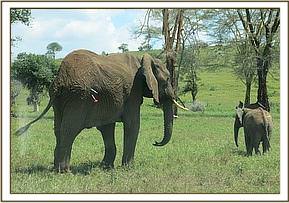

Upon physical examination the elephant was found to have an infected wound on its left hind limb. The injury was suspected to be as a result of a gunshot.
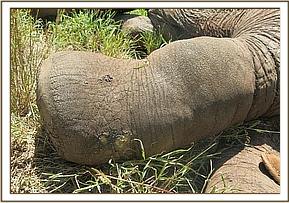

After further examination, crepitation could be felt, which suggested a fracture or splinter in the bone, however the team decided to go ahead and treat the elephant, observe her for a few days to confirm the diagnosis and prepare to rescue the calf in the event that the mother needed to be euthanized. The dead tissue around the wound was debrided and the wound was thoroughly cleaned using water and Hydrogen Peroxide and the wound was sterilized using tincture of Iodine.
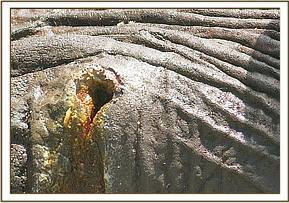

The elephant was turned using a vehicle and other wounds treated in a similar manner.


The elephant was injected with 100ml Oxytetracycline, 2 vials of Dalacin and 100ml Dexamethasone Sodium at different sites intramuscularly.
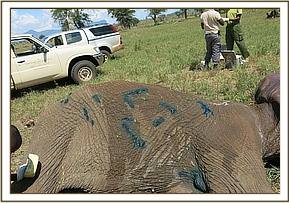

Finally, topical antibiotic ointment and grey clay was applied to the wound to facilitate healing.


Reversal
Reversal was achieved using 54mgs Diprenorphine Hydrochloride administered into the ear vein. Revival took 6 minutes.


Prognosis
Initial prognosis was guarded, but the elephant sadly had to be euthanized a week later. Unfortunately the calf joined a nearby herd of elephants and was unable to be rescued.
CASE#2 RESCUE OF MALE ELEPHANT CALF
Date: 10th December 2015
Species: African elephant (Loxodanta africana africana)
Sex: Female
Age: 2-3 years
Location: Kasigau, Tsavo West National Park
History
The KWS rangers as Kasigau reported a case of an orphaned female elephant to the Mobile Veterinary Unit and plans were made to airlift the Veterinary Doctor and rescue rangers to Kasigau. A light aircraft was made available to provide aerial support. After 1.5 hours of searching, the elephant was finally sighted in thick bush, which made it difficult to locate and dart her.
Immobilization
The elephant was immobilized using 6 mgs Etorphine Hydrochloride in a 1.5 cc dart using a Dan inject. Darting was done on foot due to the thick vegetation that the elephant was in. The calf was finally immobilized after 8 minutes with close monitoring of the KWS personnel and the DSWT rangers. Due to the high ambient temperature the elephant was doused with plenty of water to keep her body temperatures low. The ears were used as blindfolds. The calf was then loaded onto pickup ready for relocation.
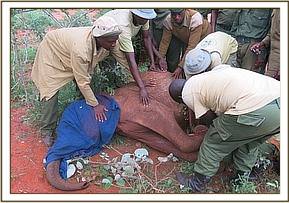
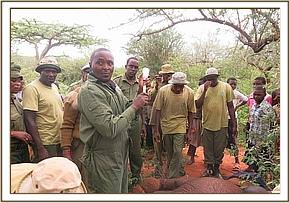
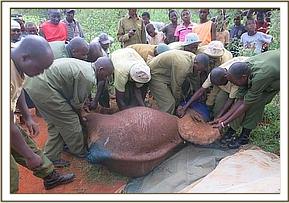

Reversal
Once safely on the rescue vehicle 18 mg Diprenorphine Hydrogenchloride was administered via the ear vein. Complete reversal took 4 minutes and once the elephant was awake, the journey to the DSWT Voi stockade began and after 1.5 hrs, the calf was safely delivered.
CASE#3 TREATMENT OF INJURED ELEPHANT
Date: 11th December 2014
Species: African elephant (Loxodanta africana africana)
Sex: Male
Age: 30 – 35 years
Location: Ol-Lemtiak
History
An adult male elephant was reported lame at Ol-Lemtiak by Big Life rangers. The Mobile Veterinary Unit attended the case and while no physical injury could be observed, lameness was evident so it was decided to immobilize the elephant for closer examination
Immobilization, examination and treatment
Immobilization was achieved using 18mg of Etorphine Hydrogenchloride in a 3ml Dan inject dart. Darting was carried out from a vehicle, despite the thick vegetation. The elephant was immobile after 12 minutes.Due to the high ambient temperature, the elephant was doused with plenty of water and Opticlox ointment was applied to the eyes to prevent drying. The ears were used as blind folds and a piece of stick was placed in the opening of the trunk to keep it open.
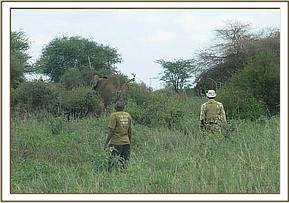

On physical examination it was evident that the elephant had a swollen left fore limb. However, no obvious physical injury could be observed leading to a suggestion that the elephant could have suffered from a fall during fighting. The elephant was then injected with 100 ml Amoxicillan and 100 ml Flunixin Meglumin, an NSAID, at different sites intramuscularly.
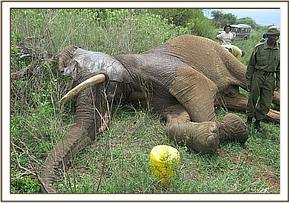

Reversal
Reversal was achieved using 54mg of Diprenorphine Hydrogenchloride administered via the ear vein. Recovery from anesthesia was smooth and the elephant stood up and walked away after about 4 minutes.
CASE#4 TREATMENT OF INJURED ELEPHANT
Date: 13th December 2014
Species: African elephant (Loxodanta africana africana)
Sex: Male
Age: 20 – 30 years
Location: Ithumba, Tsavo East National Park
History
The DSWT pilot at Ithumba reported to have spotted a male elephant with a suspected arrow head injury in the left flank area. Due to the thick vegetation, the Mobile Veterinary Unit had to locate and assess the elephant from a helicopter. Plans were made to immobilize and treat the elephant and it was decided that the elephant should be pushed to relatively open ground before being darted from the air.
Immobilization, Examination and Treatment
Immobilization was achieved using 18mg Etorphine Hydrogenchloride administered through a 3ml Dan inject dart from a helicopter. The elephant went down onto his side after 15 minutes. The trunk was kept open using a piece of stick placed across the nostril entrances. Due to the high ambient temperature the elephant was doused with plenty of water to keep the body temperatures low. The ears were used as blindfold.
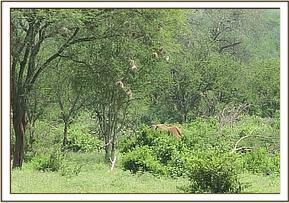



On physical examination the elephant was found to have an approximately 5 inch deep wound, which was 1-2 weeks old, on the left flank region. The wound was septic and had necrotic tissue. The wound is likely to have been caused by an arrow head which had fallen out over time. The dead tissue was debrided and removed using clean water and Hydrogen Peroxide. The wound was sterilized using tincture of Iodine. An opening on the ventral side of the wound was made for drainage to prevent further infection. Topical antibiotic cream and green clay was then applied into the wound to facilitate healing and avoid infection. The elephant was then injected with 100 ml Amoxicillin, 1200 mg Clindamycin and 100 ml Dexamethasone Sodium at different sites intramuscularly.
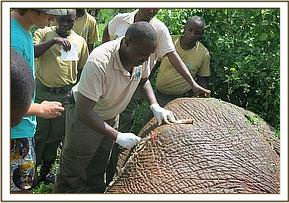
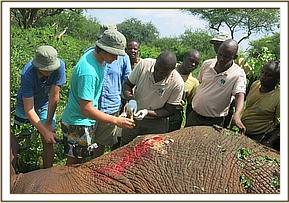
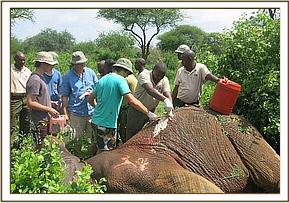

Reversal
Reversal was achieved using 60mgs Diprenorphine Hydrochloride, which was injected into the ear vein. It took about 6 minutes for the elephant to fully regain consciousness.
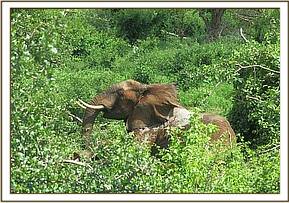

Prognosis
Good
Conclusion
The Southern Conservation Area Mobile Veterinary Unit is grateful to all individuals and organisations that played a role in assisting us throughout the year. Many thanks especially to The David Sheldrick Wildlife Trust, The Samuel J and Ethel Lefrak Charitable Trust and The Kenya Wildlife Service for their continued support, which allows this unit to alleviate animal suffering by immediately responding to clinical interventions and wildlife rescues.
